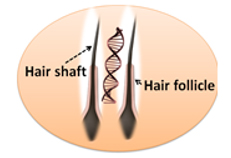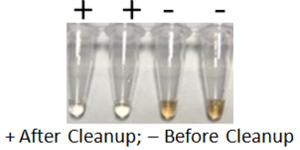
The Significance of Hair in Forensics and Medical Research
Hair is one of the most commonly found evidence at crime scenes and is gaining importance as a sample type for medical research inquiries. In criminology, hair has been used for population-based statistical analysis and DNA-based analysis. DNA testing using hair samples is most valuable when a short repeat analysis of nuclear DNA (nuDNA) is performed and the hair’s root and adherent tissue are present.
Advantages of Hair in Genetic Genealogy
Rootless hair has distinct advantages in forensic circumstances. Hair is insoluble, preserving DNA for centuries, and the extracted DNA is less susceptible to microbial contamination than bone and teeth samples. Moreover, a single hair is a distinct biological entity, which eliminates the concern of sample mix-ups in DNA-based forensics studies.
The Structure of Hair and its DNA
The hair follicle and hair shaft are the two sections of hair from which DNA can be extracted and purified. The hair follicle can isolate cellular DNA (nuDNA) and mitochondrial DNA (mtDNA), while the hair shaft often contains mtDNA and may have little nuclear material. Shed hair, which accounts for up to 90% of hair samples obtained at crime scenes, undergoes keratinization, stiffening, and nucleus breakdown. On the other hand, unwashed hair has a higher DNA output due to surrounding cells adhering to the hair shafts, which can be a source of nuDNA. Although some nuclear DNA is known to remain in rootless hair shafts, it is in small quantities and of highly varied quality.

Mitochondrial DNA Sequencing
MtDNA analysis can be used to connect human hair to a suspect. Unlike nuDNA, mtDNA lacks selective potential due to its ubiquity within the maternal lineage, making it difficult to differentiate between a grandmother and her daughter or grandchildren. MtDNA sequencing can also provide important information in species identification, as not all hair samples are human.
Nuclear DNA for Short Tandem Repeat (STR) Typing
Forensic laboratories usually examine hair evidence for the presence of root material before processing it. If the sample lacks root material, it is frequently not processed or sent for mtDNA sequencing, which has historically proven more successful than nuDNA on hair shafts. However, recent studies have shown that despite being fragmented, nuclear DNA can be retrieved from shed hair, and it accounts for most of the total DNA, eliminating the assumption that only mtDNA can be recovered from rootless hair. This method has enabled the characterization of nuDNA in telogen hairs that would not have been achievable using conventional techniques.
Optimizing DNA Extraction from Hair Shafts
DNA extraction is the first step in the forensic analysis of rootless hair. To extract ultrashort DNA from a single rootless hair, it is critical to optimize the settings to maximize the yield and purity of DNA collected from diverse samples using various procedures. A streamlined method for extracting DNA from hair shafts eliminates DNA contamination while reducing analysis time, making it valuable to the forensic and population-based research communities. The BcMag™ Rootless Hair DNA Purification Kit is designed to extract pigment-free nucleic acids from single rootless hair efficiently and sequentially, using magnetic beads and an optimized demineralization buffer to yield high-quality DNA. The purified genomic DNA has the highest integrity and can be used in various downstream applications such as qPCR, STR, etc.

Workflow of Hair Shaft DNA purification and Results
1.
Lyse the hair at 95°C for 2 hours.
2.
Add magnetic beads to bind the DNA.
3.
Wash the beads.
4.
Elute DNA from the beads.

Learn More
Instruction Manual
MSDS
DNA & RNA Purification Related Products →General Reference
1.
Brandhagen MD, Loreille O, Irwin JA. Fragmented Nuclear DNA Is the Predominant Genetic Material in Human Hair Shafts. Genes. 2018 Dec;9(12):640.
2.
Melton T, Holland C. Routine forensic use of the mitochondrial 12S ribosomal RNA gene for species identification. Journal of forensic sciences. 2007 Nov;52(6):1305-7.
3.
Luo S, Valencia CA, Zhang J, Lee NC, Slone J, Gui B, Wang X, Li Z, Dell S, Brown J, Chen SM. Biparental inheritance of mitochondrial DNA in humans. Proceedings of the National Academy of Sciences. 2018 Dec 18;115(51):13039-44.
4.
Opel KL, Fleishaker EL, Nicklas JA, Buel E, McCord BR. Evaluation and quantification of nuclear DNA from human telogen hairs. Journal of forensic sciences. 2008 Jul;53(4):853-7.
5.
Brown H, Thompson R, Murphy G, Peters D, La Rue B, King J, Montgomery AH, Carroll M, Baus J, Sinha S, Wendt FR. Development and validation of a novel multiplexed DNA analysis system, InnoTyper® 21. Forensic Science International: Genetics. 2017 Jul 1;29:80-99.
6.
Grisedale KS, Murphy GM, Brown H, Wilson MR, Sinha SK. Successful nuclear DNA profiling of rootless hair shafts: a novel approach. International journal of legal medicine. 2018 Jan 1;132(1):107-15.
7.
Brandhagen MD, Loreille O, Irwin JA. Fragmented Nuclear DNA Is the Predominant Genetic Material in Human Hair Shafts. Genes. 2018 Dec;9(12):640.
8.
Parker GJ, Leppert T, Anex DS, Hilmer JK, Matsunami N, Baird L, Stevens J, Parsawar K, Durbin-Johnson BP, Rocke DM, Nelson C. Demonstration of protein-based human identification using the hair shaft proteome. PloS one. 2016 Sep 7;11(9):e0160653.



